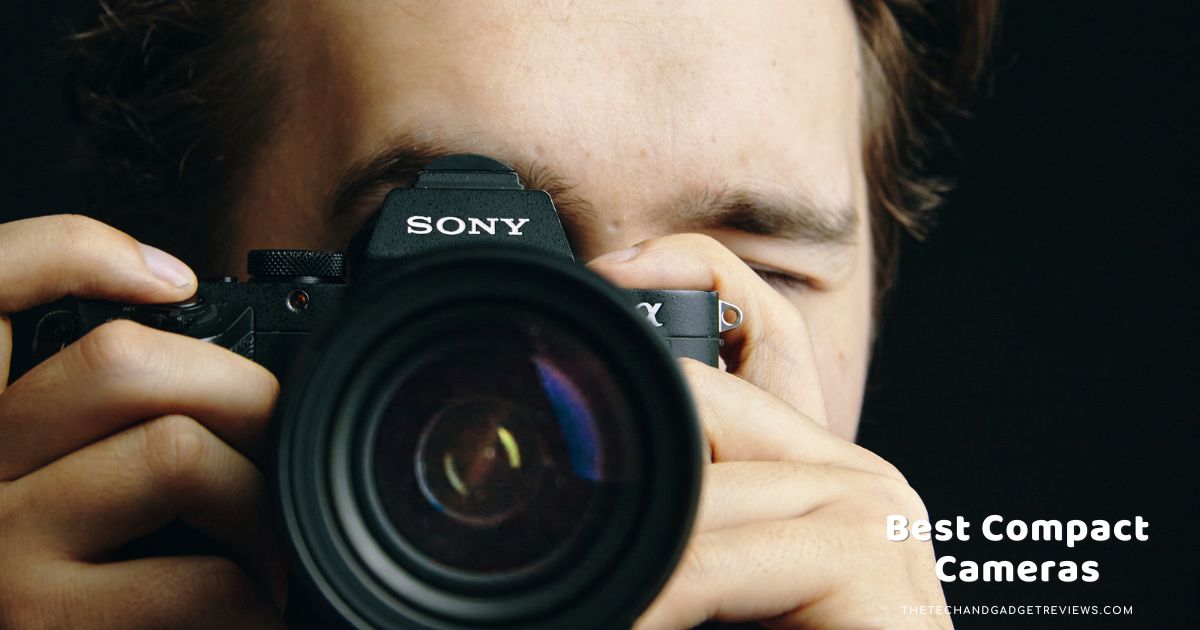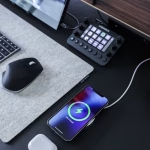
Do you love capturing moments on the go? In this guide, we explore the best compact cameras that offer high-quality images without the hassle of interchangeable lenses. Ideal as a secondary option for DSLR or mirrorless users, these compact cameras are small enough to fit in a jacket pocket but deliver impressive performance and features. We’ve selected models with large sensors and a blend of automatic and manual controls, ensuring they cater to the necessities of both enthusiasts and professionals. Check out our guide to the best point-and-shoot cameras for more straightforward and more affordable options.
10 Best Compact Cameras for Point-and-Shoot
Fujifilm X100VI
The Fujifilm X100VI is the best overall compact camera, blending a stunning retro design with exceptional build quality. Its 40MP X-Trans CMOS 5 HR sensor and advanced in-body image stabilization deliver outstanding stills and video performance. The X100VI’s hybrid viewfinder and manual controls offer a tactile, engaging photography experience, while its improved video capabilities—supporting up to 6.2K resolution—enhance its versatility. Despite the premium price and a few limitations, such as the fixed 23mm lens and a 6K video mode crop, the X100VI remains a top choice for enthusiasts seeking a high-quality compact camera.
Though the X100VI’s cost is high and its video shooting options are somewhat restricted by its two-way tilting screen, which can make vlogging and recording from awkward angles challenging, it’s iconic design and substantial feature upgrades justify the investment. The camera’s superior build, combined with the latest enhancements in image quality and stabilization, make it a compelling option for those who appreciate a classic aesthetic and robust performance. If you prioritize a premium, retro-inspired camera with top-notch functionality, the Fujifilm X100VI is hard to beat.
Sony ZV-1
The Sony ZV-1 is explicitly tailored for YouTubers and vloggers, offering a compact design with impressive features that cater to content creation. Its 1-inch sensor and versatile 24-70mm f/1.8-2.8 lens deliver sharp images and 4K video, while the super-fast autofocus ensures that you stay in focus even during dynamic shoots. The vari-angle touchscreen allows for easy self-recording and selfies, and the supplied mic windshield enhances audio quality, making it a strong contender for anyone looking to produce high-quality videos on the go.
While the ZV-1 excels in many areas, it does have some drawbacks. The rear screen is smaller than ideal and lacks a 16:9 aspect ratio, which could be limiting for video review and playback. Additionally, it does not include a viewfinder, which might disadvantage some users. Despite these minor issues, the camera’s impressive autofocus, good video performance, and affordability make it a solid choice for vloggers who need a portable and efficient tool for their content creation needs.
Ricoh GR Ix
The Ricoh GR IIIx is a top choice for street photographers thanks to its compact size and powerful features. Its 24.2MP APS-C sensor and 40mm f/2.8 lens deliver high-quality images in a small, portable package. The built-in ND filter and advanced sensor-shift stabilization further enhance its versatility, making it suitable for various shooting conditions. Although it only records video in 1080p, its superior image quality and fast autofocus make it an excellent tool for capturing dynamic street scenes.
However, the GR does come with a few drawbacks. The eye-level viewfinder is sold separately, which adds to the cost, and the camera’s price may be high for those with a tight budget. Despite these considerations, the GR IIIx’s combination of a large sensor, high-quality lens, and compact design makes it an exceptional choice for photographers who need a powerful yet portable tool for street and travel photography.
Panasonic Lumix LX100 II
The Panasonic Lumix LX100 II excels as a versatile compact camera, offering a great mix of still and video capabilities in a compact form. Its standout feature is the Micro Four Thirds sensor, which provides nearly the same performance as APS-C sensors but in a more portable design. This sensor, combined with a fast 24-75mm f/1.7-2.8 zoom lens, allows for excellent image quality and flexibility in various shooting conditions. The camera also supports 4K video and 4K Photo modes, making it a solid choice for high-resolution photos and high-definition video.
However, the LX100 II has a few limitations to consider. The 17MP resolution, while sufficient for most purposes, lags behind some competitors offering higher megapixel counts. Additionally, while impressive, the Micro Four Thirds sensor does not provide the shallow depth of field of larger full-frame sensors. Despite these drawbacks, the LX100 II remains a standout option for those seeking a compact camera that delivers high-quality stills and video performance, making it an excellent choice for both travelers and content creators.
OM System Tough TG-7
The OM System Tough TG-7, the latest iteration of the Olympus Tough TG-6, stands out as the top choice for a waterproof camera. With its 4K video recording capability and generous 25-100mm optical zoom, it excels in capturing high-quality footage and detailed close-ups. Its built-in GPS and robust construction make it ideal for adventurous photography, whether you’re exploring underwater or rugged landscapes. The TG-7 also features a handy microscope mode for extreme close-ups and a Field Sensor System that logs GPS coordinates and environmental data.
While the TG-7 offers impressive durability and performance, it retains many of the same features as its predecessor, which might not appeal to those seeking significant upgrades. The 12MP sensor, while functional, might not meet the needs of those desiring higher-resolution images. Despite these points, the TG-7 remains reliable and versatile for those needing a dependable waterproof camera that can handle rough conditions and diverse shooting scenarios.
Panasonic Lumix ZS80/TZ95
The Panasonic Lumix ZS80/TZ95 offers impressive zoom capabilities and a range of features at a budget-friendly price. With a 24-720mm equivalent zoom lens, this compact camera captures both expansive landscapes and distant subjects. It also offers 4K video recording capabilities and includes an integrated flash, making it versatile for various shooting conditions. Its 10fps continuous shooting mode is quick enough for capturing action shots, and the tilting 3-inch LCD screen adds flexibility in composing shots from different angles.
However, the ZS80/TZ95 does have some limitations. The viewfinder is relatively tiny, making composing images challenging, and its performance in low-light conditions is not the best. Additionally, while it offers a significant zoom range, the upgrades from its predecessor, the SZ70/TZ90, are minimal. Despite these drawbacks, the ZS80/TZ95 remains a strong choice for those seeking a compact camera with a substantial zoom range and valuable features without a hefty price tag.
Canon PowerShot G1 X Mark III
The Canon PowerShot G1 Mark III is an upscale compact camera that provides outstanding image quality in a surprisingly compact form. It features a 24.2-megapixel APS-C sensor—similar to the one in the Canon EOS 80D DSLR—it captures sharp, detailed stills. Its lens offers a practical 24-72mm zoom range and retracts into the body, making the camera highly portable. Despite its compact size, it maintains excellent image quality, though it only supports Full HD video rather than 4K.
However, the G1 X Mark III has some limitations to consider. The aperture ranges from f/2.8 at 24mm to f/5.6 at 72mm, which can affect performance in low-light conditions and limit the depth of field control. Additionally, while it offers a continuous shooting rate of 7fps and Wi-Fi connectivity for easy image transfer, it does not provide 4K video capabilities. Despite these drawbacks, its combination of a large sensor and compact form makes it an attractive choice for those who prioritize still photography and are willing to invest in a high-quality compact camera.
Panasonic Lumix LX15
The Panasonic Lumix LX15 (known as the LX10 in North America) is a standout compact camera featuring a 1-inch, 20.1-megapixel sensor that offers excellent image quality in a pocket-sized form. It boasts a fast lens with a maximum aperture of f/1.4 at a wide angle, making it particularly adept at low-light photography. The camera offers 4K video recording and features a swift, accurate autofocus system that rivals larger cameras. With a 24-72mm zoom range and a responsive tilting touchscreen, it balances high performance with compact convenience.
Despite its impressive features, the LX15 has a few drawbacks. It lacks an electronic viewfinder, relying solely on the rear screen for composing shots, which can be less ideal for specific shooting conditions. Additionally, the camera’s design has rounded edges, which may make it less comfortable to hold securely. While it excels in many areas, if you prefer a camera with a more substantial grip or the option to add a viewfinder, you might find the LX100 II a better investment despite its higher price.
Leica Q3
The Leica Q3 is the best compact camera for those seeking high-megapixel performance, featuring a remarkable full-frame 60-megapixel sensor. This camera merges outstanding image quality with a fast 28mm f/1.7 prime lens, making it ideal for those who appreciate sharp, high-resolution photos. It also offers impressive video capabilities, including 8K recording and 4K at 60p, a 3-inch flip touchscreen, and an electronic viewfinder (EVF) for flexible shooting. The Leica Q3 embodies the renowned build quality and handling of Leica cameras, offering a premium experience in a compact form.
However, the Q3’s luxury price tag is a significant drawback, positioning it at the high end of the market. The fixed 28mm lens, while fast and excellent in image quality, limits versatility compared to zoom lenses. Additionally, the absence of an optical viewfinder—replaced by the high-resolution EVF—might not appeal to those who prefer the traditional viewfinder experience. For those willing to invest in a top-tier camera and comfortable with its limitations, the Leica Q3 offers an unparalleled combination of resolution and build quality.
Polaroid Go
The Polaroid Go is an exceptional choice for those who adore retro instant prints and value compact design. Claimed as the “world’s smallest analog, digital camera,” it offers a delightful combination of portability and classic instant photo appeal. Its compact, boxy design is among the smallest in the instant camera category, making it easy to carry around. The Go produces credit card-sized prints with charming pastel tones and fine detail, and its point-and-shoot functionality ensures that capturing moments is straightforward and enjoyable. With features like a rechargeable battery, manual flash override, self-timer, and double-exposure modes, it caters to simplicity and creative exploration.
However, the Polaroid Go has some limitations. Its fixed focus can be challenging for close-up shots, and it lacks a dedicated macro mode, which may restrict its versatility compared to other instant cameras. Additionally, while the camera itself is affordable, the cost of instant film refills is relatively high, making it a pricier option for frequent use. Despite these drawbacks, the Go remains a fun, accessible, and surprisingly capable choice for instant photography enthusiasts who prioritize portability and the tactile joy of physical prints.
Conclusion:
Each of the ten compact camera reviewed offers unique features catering to different needs. The Fujifilm X100VI excels with its high-resolution sensor and classic design, while the Sony ZV-1 is tailored for vloggers with its excellent video capabilities. The Panasonic Lumix LX100 II and LX15 offer impressive performance for stills and video; though they have some limitations, the OM System Tough TG-7 is perfect for rugged conditions. Meanwhile, the Leica Q3 delivers high megapixel performance and premium build quality, and the Polaroid Go provides a fun, retro option for instant prints in a highly portable form.


